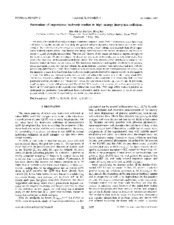| dc.creator | Li, Ba0-An | |
| dc.creator | Ko, Che Ming. | |
| dc.date.accessioned | 2011-09-13T21:27:46Z | |
| dc.date.available | 2011-09-13T21:27:46Z | |
| dc.date.issued | 1995 | |
| dc.identifier.citation | Bao-An LI and Che Ming Ko. Phys.Rev.C 52 2037-2063 1995. "Copyright (1995) by the American Physical Society." | en |
| dc.identifier.uri | http://dx.doi.org/10.1103/PhysRevC.52.2037 | |
| dc.identifier.uri | https://hdl.handle.net/1969.1/126849 | |
| dc.description | Journals published by the American Physical Society can be found at http://publish.aps.org/ | en |
| dc.description.abstract | We present the detail of a newly developed relativistic transport model (ART 1.0) for high energy heavy-ion collisions. Using this model, we first study the general collision dynamics between heavy ions at the AGS energies. We then show that in central collisions there exists a large volume of sufficiently long-lived superdense hadronic matter whose local baryon and energy densities exceed the critical densities for the hadronic matter to quark-gluon plasma transition. The size and lifetime of this matter are found to depend strongly on the equation of state. We also investigate the degree and time scale of thermalization as well as the radial flow during the expansion of the superdense hadronic matter. The flow velocity profile and the temperature of the hadronic matter at freeze-out are extracted. The transverse momentum and rapidity distributions of protons, pions, and kaons calculated with and without the mean field are compared with each other and also with the preliminary data from the E866/E802 Collaboration to search for experimental observables that are sensitive to the equation of state. It is found that these inclusive, single particle observables depend weakly on the equation of state. The difference between results obtained with and without the nuclear mean field is only about 20%. The baryon transverse collective flow in the reaction plane is also analyzed. It is shown that both the flow parameter and the strength of the ''bounce-off'' effect are very sensitive to the equation of state. In particular, a soft equation of state with a compressibility of 200 MeV results in an increase of the flow parameter by a factor of 2.5 compared to the cascade case without the mean field. This large effect makes it possible to distinguish the predictions from different theoretical models and to detect the signatures of the quark-gluon plasma which is expected to significantly soften the equation of state. | en |
| dc.language.iso | en | |
| dc.publisher | American Physical Society | |
| dc.subject | RELATIVISTIC NUCLEAR COLLISIONS | en |
| dc.subject | QUARK-GLUON PLASMA | en |
| dc.subject | QCD SUM-RULES | en |
| dc.subject | TRANSPORT MODEL | en |
| dc.subject | KAON PRODUCTION | en |
| dc.subject | PION SPECTRA | en |
| dc.subject | TRANSVERSE-MOMENTUM | en |
| dc.subject | DILEPTON PRODUCTION | en |
| dc.subject | PHASE-TRANSITION | en |
| dc.subject | K+ PRODUCTION | en |
| dc.subject | Physics | en |
| dc.title | Formation of Superdense Hadronic Matter in High-Energy Heavy-Ion Collisions | en |
| dc.type | Article | en |
| local.department | Physics and Astronomy | en |


